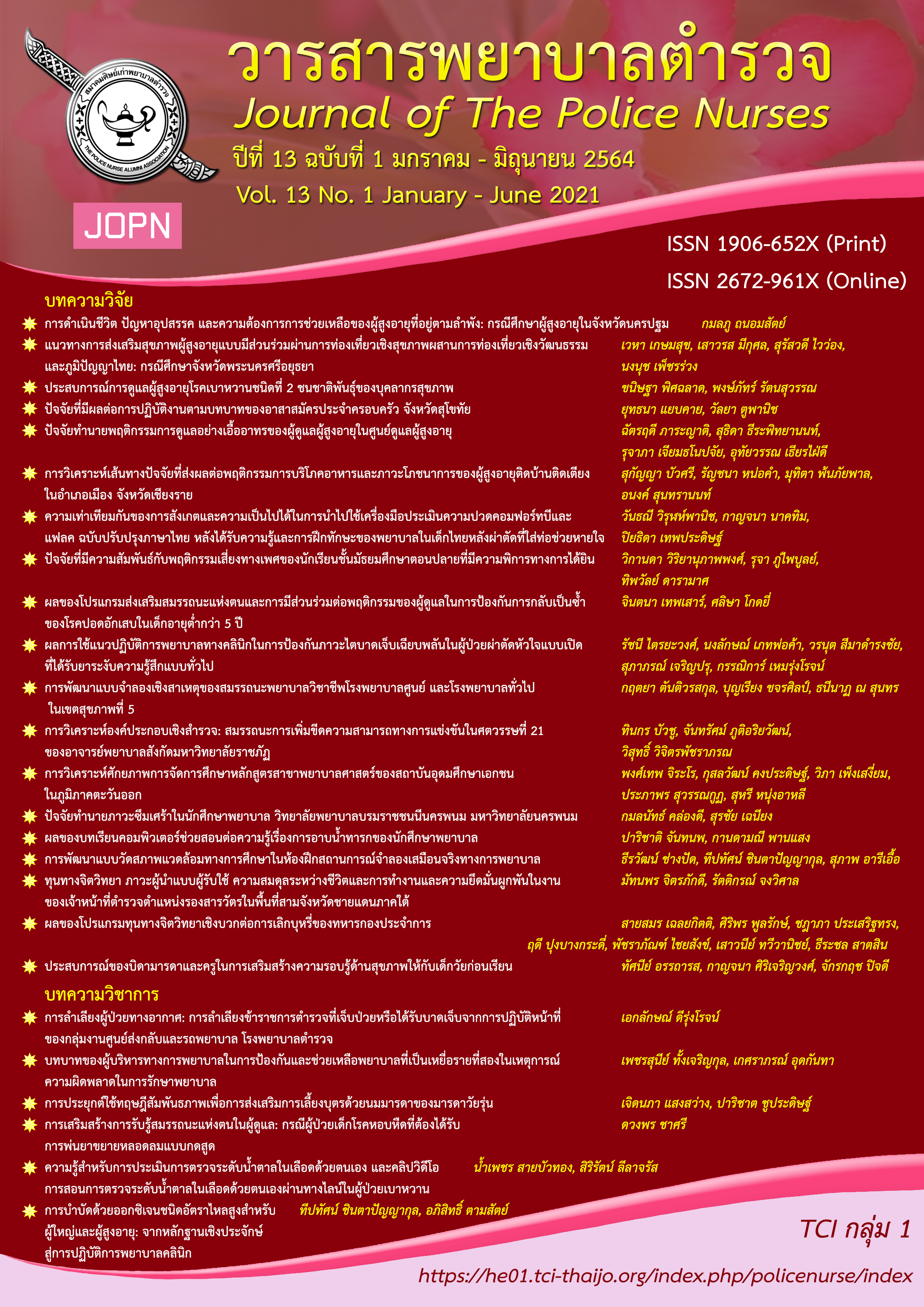KNOWLEDGE FOR THE ASSESSMENT OF SELF-MONITORING BLOOD GLUCOSE AND A VIDEO CLIP OF SELF-MONITORING BLOOD GLUCOSE VIA LINE IN PATIENTS WITH DIABETES
Keywords:
self-monitoring blood glucose levels, diabetes, HbA1cAbstract
While taking care of diabetic patients with dietary control, activities such as oral medication, insulin injection, and exercise can help the patients to better control blood glucose levels. Painless self-monitoring of blood glucose at finger sites is also an option to help control blood glucose levels in terms of following up hemoglobin A1c without waiting for the medical appointment. However, self-monitoring of blood glucose levels needs frequent reviews and practices in order to be able to self-monitor effectively. Thus, creating a video clip to teach self-monitoring blood glucose levels via the LINE application will help patients with diabetes and caregivers to have chances to review, practice, and be able to keep blood glucose levels under control.
This academic review is shown about diabetes, knowledge for assessing and monitoring blood glucose levels, the essence of self-monitoring blood glucose levels, interpretations and problems of self-monitoring blood glucose levels, a concept and theory with developing and producing the video. The contents of creating a video clip for teaching were composed of 1) the use of a painless self-monitoring device of blood glucose at the finger site, 2) self-monitoring of blood glucose test with an insulin pen, 3) techniques of monitoring blood glucose levels, 4) recording and interpreting glucose level, and 5) solving problems of abnormal blood glucose levels. Patients with diabetes are able to improve their knowledge and skills of assessing and following up on blood glucose levels by themselves effectively and safely. Moreover, they can also prevent themselves from diabetes complications.
Downloads
References
Aekplakorn, W. (2016). The fifth health examination survey of Thai population, 2014. Nonthaburee: Auksorn Graphic and Designs.
American Diabetes Association. (2020). Standards of medical care in diabetes 2020. The Journal of Clinical and Applied Research and Education, 43, S1-S205.
Diabetes Association of Thailand. (2017). Clinical practice guideline for diabetes 2017. Bangkok: Roumyen Media.
Garg, S. K., & Hirsch, I. B. (2016). Self-monitoring of blood glucose. Diabetes Technology Therapy, S3-S9.
Knowles, S. R., Lee, K., Paterson, M., Shah, B. R., Mamdani, M. M., Juurlink, D. N., & Gomes, T. (2017). Self-monitoring of blood glucose: Impact of quantity limits in public drug formularies on provincial costs across Canada. Canadian Journal of Diabetes, 41(2), 138-142.
Leventhal, H., Diefenbach, M., & Leventhal, E. A. (1992). Illness cognition: Using common sense to understand treatment adherence and affect cognition interactions. Cognitive Therapy and Research, 16(2), 143-163.
Monkolsumrit, S., Nigard, H., Dorchai, H., & Rodaree, P. (2013). HbA1c, self-care’s behavior change and quality of life of type 2 diabetes patient who used and non-used self-monitoring blood glucose in rural community. Journal of Public Health, 43(3),230-243.
National Institute of Diabetes and Digestive and Kidney Diseases. (2016). Low blood glucose (Hypoglycemia). Retrieved from https://www.niddk.nih.gov/health-information/diabetes/overview/preventing-problems/low-blood-glucose-hypoglycemia
Pavithran, A. A., Ramamoorthy, L., Suryanarayana, B. S., Murugesan, R., & Kumari, M. J. (2020). Comparison of fingertip vs palm site sampling on pain perception, and variation in capillary blood glucose level among patients with diabetes mellitus. Journal of Caring Sciences, 9(4), 182-187.
Saeedi, P., Petersohn, I., Salpea, P., Malanda, B., Karuranga, S., Unwin, N., . . . On behalf of the IDF Diabetes Atlas Committee. (2019). Global and regional diabetes prevalence estimates for 2019 and projections for 2030 and 2045: Results from the International Diabetes Federation Diabetes, 9th edition. Diabetes Research and Clinical Practice, 107843. https://doi.org/10.1016/j.diabres.2019.107843
Sakurai, K., Kawai, Y., Yamazaki, M., & Komatsu, M. (2018). Prediction of lowest nocturnal blood glucose level based on self-monitoring of blood glucose in Japanese patients with type 2 diabetes. Journal of Diabetes and Its Complications, 32(12), 1118-1123.
Stephenson, E. J., Smiles, W., & Hawley, J. A. (2014). The relationship between exercise, nutrition, and type 2 diabetes. Medicine Sport Sciece Journal, 60, 1-10. https://doi.org/10.1159/000357331
Wongsunopparat, B., Jerawatana, R., Bhirommuang, N., & Saibuathong, N. (2011). Nursing management of hypoglycemia in persons with diabetes: Clinical nursing practice guideline utilization. Ramathibodi Nursing Journal, 18(2), 166-177.
Downloads
Published
How to Cite
Issue
Section
License
ผลงานที่ได้ตีพิมพ์แล้วจะเป็นลิขสิทธิ์ของวารสารพยาบาลตำรวจ















